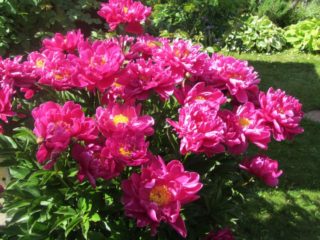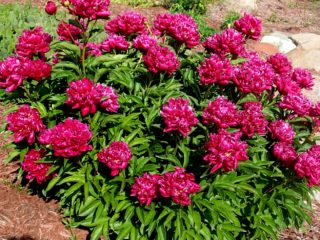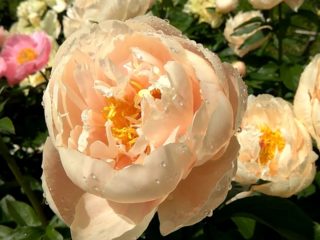Content
Peonies reproduce mainly vegetatively - by parts of an adult plant. The survival rate in this case is quite good, but in order for reproduction to be successful, you need to know the basic rules.
Peony propagation methods
There are several ways in which perennial peonies reproduce. Among them are:
- propagation by dividing the bush, this method allows you to preserve all varietal characteristics, but it is used only for adult bushes;
- propagation by stem cuttings, a rather troublesome and complex method, allows you to preserve the characteristics of varietal peonies, but is not suitable for breeding hybrids;
- propagation by root cuttings, the characteristics of the variety when using the method are preserved in some hybrids and medicinal peony, due to which the method is especially popular;
- propagation by pruning is a simple method in which the characteristics of the variety are preserved, but it can be practiced, like classical division, only for mature bushes.
Seed propagation should be placed in a separate category. It is possible to increase the population of flowers on a site in this way, but seed propagation is rarely chosen. It does not preserve the characteristics of the variety; not all peonies produce seeds, and besides, the germination rate is not very high.
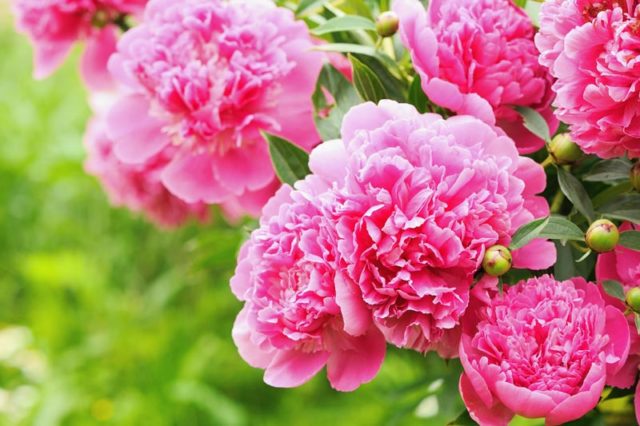
Flowers are mainly propagated vegetatively - it’s more convenient and faster.
Peony propagation times
Flowers can be propagated in both spring and autumn. But at the same time, you need to choose methods that are appropriate to the season, since the plant cannot be propagated by any means throughout the year.
When and how to propagate peony in spring
The spring period is well suited for the following methods of peony propagation:
- Dividing a peony bush in spring. The procedure is allowed, including at the beginning of the growing season. At the same time, it is better not to touch flower bushes immediately after the snow melts, but from mid-April you can already dig up and divide the plant.
- Stem cuttings. Propagation can be carried out in late spring and early summer, approximately 10 days before flowering and immediately during flowering.
- Vertical layers. It is necessary to start growing peony layerings in early spring, at the very beginning of the growing season, after the snow cover has melted.
- Pruning. Peony propagation by this method is also carried out in early spring after the snow has melted; in fact, the method is a variation of the usual division of the bush.
The advantages of spring propagation are that during the season, young cuttings, layering or divisions have time to get stronger and easily survive the winter.
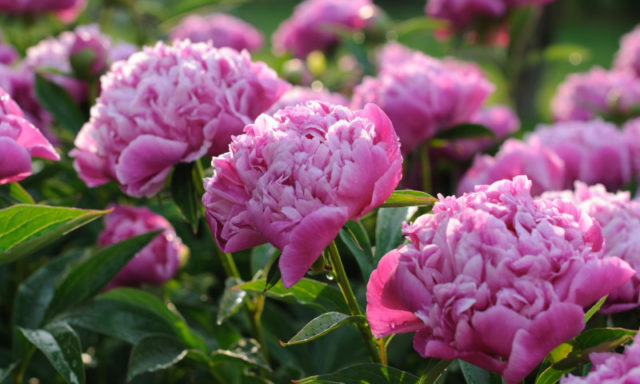
Reproduction can be carried out both in spring and autumn
When and how to propagate peonies in the fall
Autumn propagation of peonies is usually carried out until October; the plant needs at least a month to take root properly. You can use the following methods in the fall:
- root cuttings — pieces of roots are usually harvested from early August to mid-September, at the moment when the buds have already matured, but small roots have not yet formed;
- bush division — the procedure is carried out from September to October, before the onset of the first cold weather.
How to propagate peonies from cuttings
The cutting method is usually used for breeding the most valuable varieties of peonies. This is due to the fact that the risks of damaging the uterine bush are minimal. Even if propagation is unsuccessful, the existing plant will not be harmed.
Propagation of peonies by stem cuttings
Stem cuttings are not the easiest method, and peony shoots do not always take root. Therefore, before the procedure, it is recommended to prepare more cuttings, up to 20% of the stems from an adult plant 5 years old and older.
The reproduction algorithm is as follows.
- Select several healthy stems from the middle of the peony bush. Then they are either torn off with a sharp movement along with the underground part, or cut off near the ground itself.
- Using pruning shears, the stems are divided into 2-3 cuttings, each of them must have at least 2 internodes.
- The cuttings in the lower part are cut under the leaf, removing the leaf itself, the upper leaf is cut by a third.
- The cuttings are soaked for 2.5 hours in Kornevin’s solution from the lower cut side - this stimulates the peony to grow faster.
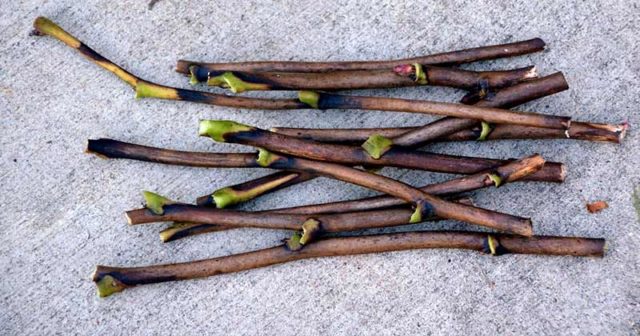
Stem cuttings are not suitable for hybrid varieties
You can grow a peony from a cutting either in an open garden bed or in a tin at home. In both cases you will need the same soil - equal parts of leaf soil are mixed with compost, and a few centimeters of clean sand are poured on top.
After preparation, the cuttings are buried 5 cm in sand with a slight slope, moistened and covered with film or a glass jar. The shoots must be sprayed with water three times a day, and after 3 weeks of cultivation, ventilate daily, first for half an hour, then up to 3 hours. The temperature for cuttings should not exceed 25 °C.
If cuttings are grown at home, then for the winter they should be allowed to lower their temperature to approximately 15 °C.
In an open garden bed, cuttings are covered with brushwood, straw or sawdust during the winter months. At the beginning of next spring, after the snow has melted, the shoots are carefully transplanted into the ground to a permanent place.
The stem propagation method is suitable only for varietal peonies. Interspecific hybrids do not reproduce in this way.
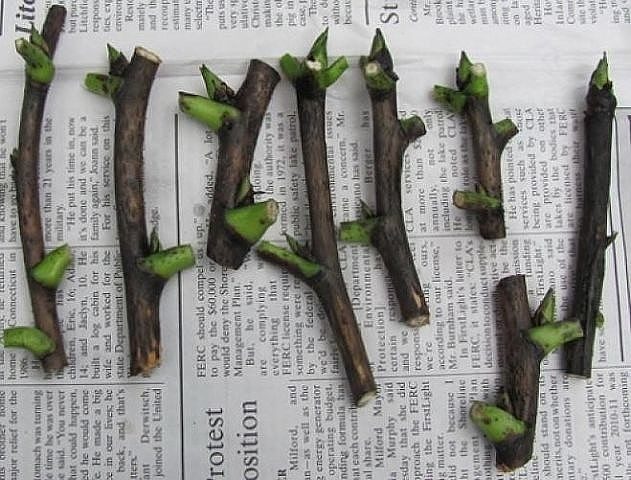
Cuttings need to be harvested in large volumes; not all of them will take root.
Propagation of peonies by root cuttings
A root cutting is a small section of a peony's rhizome that has its own root and sprout eye. Plant propagation is carried out according to the following algorithm:
- The peony bush is dug out of the ground and carefully cleaned of old roots and dirt. The rhizome is divided into pieces of 5-7 cm, each piece should contain a bud and a young root.
- The planting material is soaked for disinfection in a solution of potassium permanganate for 2 hours, and then slightly dried in fresh air and rolled in crushed coal.
- The root cuttings are left overnight so that a crust has time to form on the cuts.
After this, the planting material is placed on temporary beds with nutritious soil or in tin cans with prepared soil from fertile soil and compost. Root cuttings are buried 4 cm deep, kept in a lighted place with light shade and watered regularly. Both at home and in open conditions, young shoots should appear in the spring, after which the peony continues to be cared for for another year, and then transplanted to a permanent place.
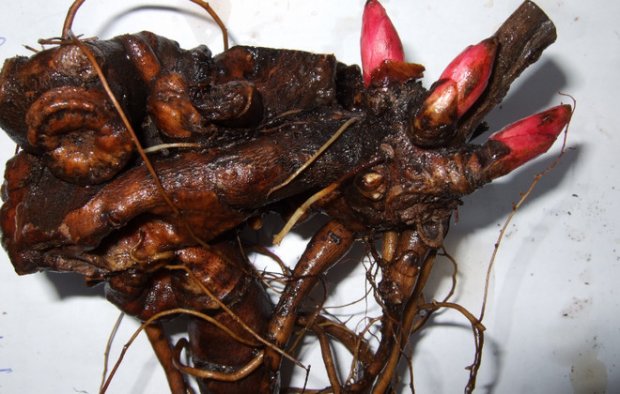
Root cuttings can be carried out both at home and on the site
How to propagate peonies by vertical layering
A very simple and convenient way to propagate peonies is to grow vertical layering in a tin can. The procedure looks like this:
- in early spring you need to take a long tin can without a lid, cut out the bottom, wash it and properly disinfect it;
- the jar is placed on the selected shoot of an adult peony bush - a strong and healthy young stem;
- As the shoot grows, nutrient soil is added to the jar - black soil, river sand and rotted manure are mixed in equal proportions;
- The soil in the jar is regularly watered, and to prevent the soil inside from overheating under the sun's rays, the outside of the jar is wrapped in cardboard and polyethylene.
Caring for the shoot continues all summer, and with the onset of autumn, the stem under the jar is cut with a sharp knife. The shoot itself, which manages to develop roots inside the jar during the summer, is carefully removed and transplanted into a prepared hole in the selected area.
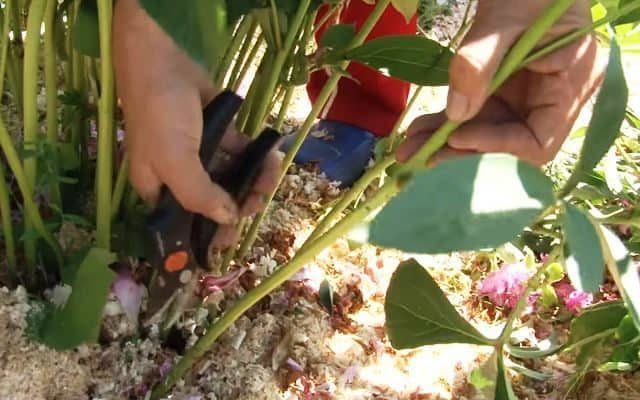
It is very easy to propagate flowers using vertical layering.
This method is only suitable for propagating milk-flowering varieties of peonies, and is not suitable for tree-like plants. Its effectiveness is very high, and the damage to the mother bush and the shoot itself is insignificant.
Reproduction of peonies by dividing the bush
Bush division remains the most popular method of propagating mature plants. The method is suitable for all varieties of peony, while the characteristics are completely preserved.
When is the best time to divide peonies for propagation?
The best time to divide a peony bush occurs twice a season, in the spring at the end of April or early May, and in the fall, at the end of August or early September. When carrying out the procedure, you need to take into account that divisions planted in the spring may develop slowly. In the first year of life, they simply will not have time to take root properly, since they will almost immediately begin to build up green mass.
In the fall, the procedure must be carried out before September 15, otherwise the first autumn frosts will not allow the peony to take root.
Reproduction of peonies by dividing the bush in the fall is recommended for plants older than 5 years. They have a more developed root system that tolerates intervention well.
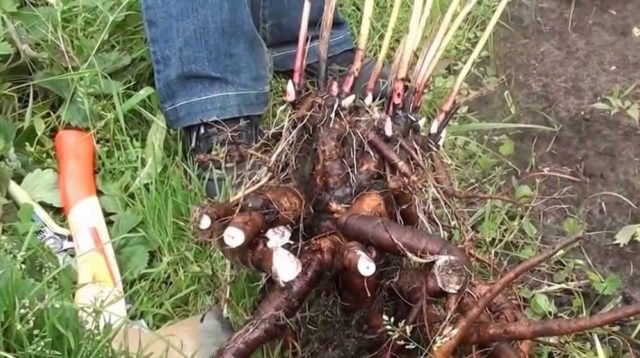
Dividing the bush is the main method for adult plants
How to dig up and divide a peony bush
Dividing a peony bush is not a very complicated procedure, but it must be carried out according to the rules:
- On the chosen day, all the stems of the peony bush are cut off and the soil around the plant is raked.
- The root is carefully removed from the soil, trying not to damage the young adventitious roots responsible for nutrition.
- The soil from the roots is carefully shaken off, then the rhizome is carefully washed with water to clean the growth buds.
- The cleaned rhizome is placed in a shaded, dry place for several hours to dry slightly, and then the adventitious roots are cut to 10-12 cm in length.
The dried rhizome is cut into several parts with pruning shears or a sharp knife. Each peony division with buds should retain 2-3 eyes and a pair of adventitious roots of at least 1 cm in diameter. The cut rhizome of the mother bush is sprinkled with charcoal in the cut areas, and at the same time, during the procedure, all rotten areas on it are cut off.
How to plant a peony division
It is best to plant peony cuttings in an open, sunny area. Before planting, the material is disinfected for half an hour in a dark pink solution of potassium permanganate.
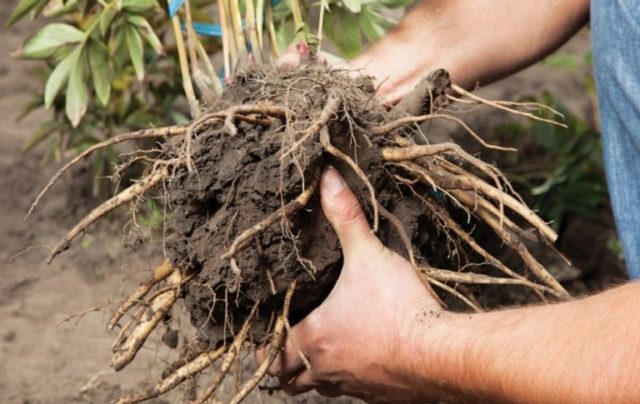
On each of the divisions there should be growth buds and feeding roots
The planting hole for peonies is prepared in 3 days, the depth should be about 60 cm. Planting is carried out simply:
- nutrient soil is poured into the hole - 3 buckets of humus, a glass of ash and complex fertilizers in granules;
- the division is placed on a mound of soil inside the hole and the space between the roots is carefully filled with soil;
- The hole is filled to the end and the rhizome is watered abundantly.
After planting, the growth buds of the division should be level with the ground or no deeper than 5 cm, otherwise it will be difficult for the peony to grow. The plant will be able to bloom as early as next year if planted successfully, or after 3 years if growth is slow.
How to propagate a peony by pruning
A convenient method of propagation, suitable for all varieties of peony, is pruning the rhizome. The method is as follows:
- in the spring, after the soil has thawed, the soil around the peony bush is raked to a depth of about 15 cm;
- Using a sharpened shovel, cut off the upper part of the root system along with the buds of renewed growth, approximately 7 cm below them;
- the upper part of the bush is separated from the main rhizome and easily breaks up into separate sections.
The method allows you to get several dozen strong cuttings from one adult bush. The advantage is that the entire bush does not need to be dug up, this simplifies the task for the gardener and also reduces damage to the mother plant.
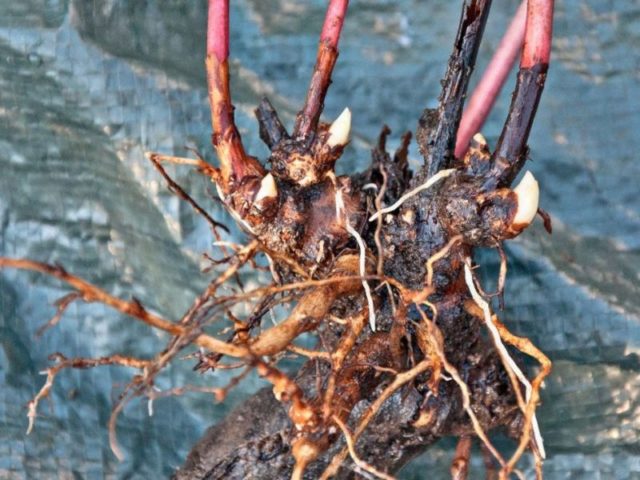
Pruning - a simple option for dividing the rhizome
Rules of care
After cuttings, dividing peonies in the fall or pruning, it is important to provide the mother plant and young peonies with good care. This is easy to do:
- After division, it is important to protect the uterine bush from possible infection. To do this, fresh cuts on the rhizome and above-ground parts need to be treated with a solution of potassium permanganate, and then sprinkled with ash or charcoal.
- After dividing the bush and disinfection, the mother plant must be covered with fertile soil and mulched with sawdust in a 10 cm layer. The peony is restored quickly, already by the fall, if spring propagation was carried out, and by the next season after division in the fall.
As for rhizomes and planted cuttings, it is important to ensure, first of all, good watering and stable temperatures. You need to moisten the soil about once a week. If the weather changes frequently, or the peony is planted in a windy area, the cutting or cutting can be covered with film, this will create greenhouse conditions.
Before the onset of winter, it is important to properly protect the mother bush, divisions and cuttings from frost. Usually the peony is covered with straw, fallen leaves or sawdust in a dense layer, this will protect the plants from freezing. With the onset of spring, it is important to apply complex fertilizers containing nitrogen; they stimulate young peonies to grow and help the mother bush recover.
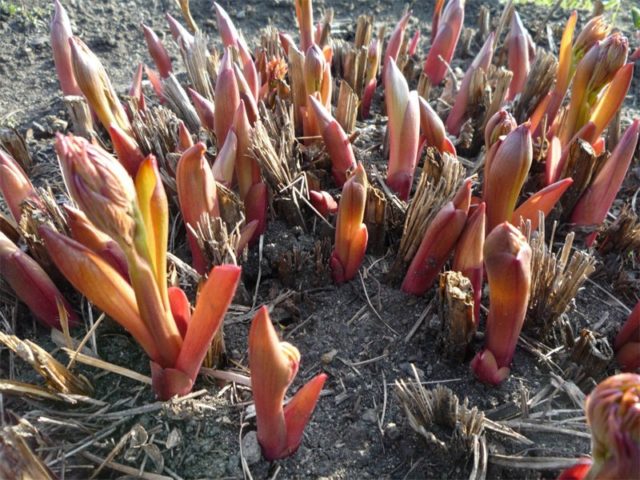
Flowers tolerate pruning and division very well and quickly begin new growth.
Conclusion
Peonies are propagated by several vegetative methods - stem cuttings, layering and root pieces. In all cases, peony requires a careful approach to the propagation procedure and needs high-quality care, but it responds to breeding quite well and quickly begins to grow.

